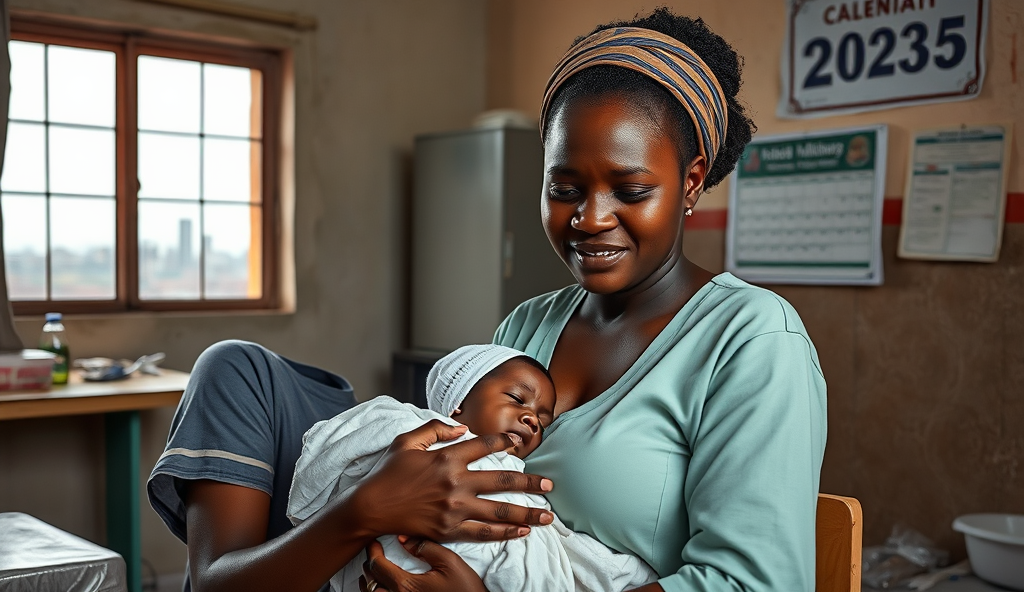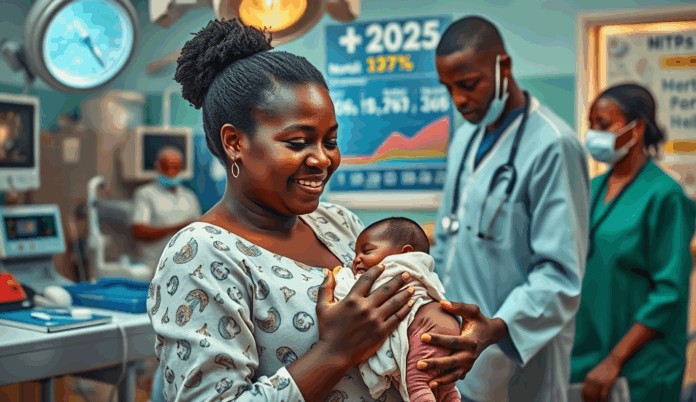Introduction to Maternal Mortality in Nigeria
Nigeria accounts for nearly 20% of global maternal deaths, with an estimated 82,000 women dying annually from pregnancy-related complications according to UNICEF. This crisis persists despite global advancements in maternal healthcare, highlighting systemic gaps in Nigeria’s health infrastructure and socioeconomic conditions.
The causes of maternal deaths in Nigeria range from preventable conditions like hemorrhage and infections to structural barriers such as limited access to skilled birth attendants. Northern states like Sokoto and Zamfara report mortality rates three times higher than the national average, reflecting regional disparities in healthcare access.
Understanding these challenges sets the stage for examining the precise definition and scope of maternal mortality, which will be explored next. This foundational knowledge is crucial for addressing Nigeria’s persistent maternal health crisis effectively.
Key Statistics

Definition and Scope of Maternal Mortality
Nigeria accounts for nearly 20% of global maternal deaths with an estimated 82000 women dying annually from pregnancy-related complications according to UNICEF.
Maternal mortality refers to deaths occurring during pregnancy, childbirth, or within 42 days postpartum due to pregnancy-related causes, excluding accidental or incidental fatalities. In Nigeria, this includes preventable conditions like hemorrhage, hypertensive disorders, and sepsis, which account for over 70% of cases according to the World Health Organization (WHO).
The scope extends beyond medical causes to encompass socioeconomic barriers such as poverty, poor education, and inadequate healthcare access, particularly in rural areas. For instance, women in Nigeria’s northern regions face higher risks due to cultural practices and limited skilled birth attendance.
Understanding this definition clarifies why Nigeria’s maternal mortality crisis persists despite global progress, setting the stage for analyzing current statistics. These insights are vital for developing targeted interventions that address both medical and systemic challenges.
Current Statistics on Maternal Mortality in Nigeria
Maternal mortality refers to deaths occurring during pregnancy childbirth or within 42 days postpartum due to pregnancy-related causes excluding accidental or incidental fatalities.
Nigeria accounts for nearly 20% of global maternal deaths, with an estimated 82,000 women dying annually from pregnancy-related complications, according to UNICEF. The maternal mortality ratio stands at 512 deaths per 100,000 live births, far exceeding the SDG target of 70 by 2030, highlighting persistent healthcare gaps.
Regional disparities remain stark, with northern states like Zamfara recording rates three times higher than southern states like Lagos due to limited healthcare infrastructure. Only 43% of births are attended by skilled personnel nationally, dropping below 20% in rural areas where traditional birth attendants dominate.
These statistics underscore the urgent need to address both medical and systemic causes of maternal mortality in Nigeria, which we explore next. The data reinforces earlier discussions on preventable conditions and socioeconomic barriers driving this crisis.
Main Causes of Maternal Mortality in Nigeria
The leading medical causes of maternal deaths in Nigeria include severe bleeding (postpartum hemorrhage) infections and hypertensive disorders like eclampsia which collectively account for over 60% of fatalities according to the National Primary Healthcare Development Agency.
The leading medical causes of maternal deaths in Nigeria include severe bleeding (postpartum hemorrhage), infections, and hypertensive disorders like eclampsia, which collectively account for over 60% of fatalities according to the National Primary Healthcare Development Agency. These preventable conditions are exacerbated by delays in seeking care, reaching facilities, and receiving adequate treatment, particularly in rural northern states with scarce healthcare resources.
Socioeconomic factors like poverty, low education levels, and cultural beliefs significantly contribute to Nigeria’s maternal mortality crisis, with 63% of rural women delivering without skilled birth attendants as revealed by NDHS data. Early marriages in northern regions further increase risks, as adolescent mothers face higher chances of obstructed labor and fistulas due to underdeveloped pelvises.
Systemic failures compound these challenges, including underfunded health systems, drug shortages, and inadequate emergency obstetric care, which we explore next. These intersecting medical and structural causes explain why Nigeria’s maternal mortality rate remains among the world’s highest despite global declines.
Poor Access to Quality Healthcare Services
Nigeria faces a critical shortage of skilled birth attendants with only 43% of deliveries attended by qualified personnel according to 2022 National Demographic Health Survey data.
Nigeria’s maternal mortality crisis is worsened by severe healthcare access disparities, with only 38% of rural facilities offering emergency obstetric care compared to 72% in urban areas, as reported by the World Health Organization. Geographic barriers and poor road networks delay critical care, especially in northern states where maternal deaths are 30% higher than the national average.
Understaffed clinics and frequent drug stockouts further limit care quality, forcing many women to rely on unqualified providers or traditional birth attendants. A 2023 study in Kano revealed that 45% of maternal deaths occurred due to complications that could have been managed with timely, adequate medical intervention.
These systemic gaps directly contribute to Nigeria’s high maternal mortality rate, setting the stage for examining the critical shortage of skilled birth attendants. The next section explores how workforce deficiencies perpetuate preventable deaths despite existing interventions.
Lack of Skilled Birth Attendants
The loss of mothers devastates Nigerian families with UNICEF estimating that 1 in 5 children whose mothers die in childbirth won’t survive past age five due to malnutrition and inadequate care.
Nigeria faces a critical shortage of skilled birth attendants, with only 43% of deliveries attended by qualified personnel according to 2022 National Demographic Health Survey data. This deficit is most acute in rural areas, where traditional birth attendants handle over 60% of deliveries despite lacking emergency obstetric skills.
The northern regions bear the brunt of this workforce crisis, with states like Sokoto having just 2.3 doctors per 10,000 people compared to Lagos’ 9.7. Such disparities force many women into risky deliveries without professional supervision, exacerbating preventable complications that often lead to maternal deaths.
These workforce gaps directly contribute to Nigeria’s high maternal mortality rate, as unmanaged complications frequently escalate into life-threatening emergencies. The next section examines how hemorrhage and infections—often preventable with skilled care—account for over 50% of these deaths nationwide.
High Prevalence of Hemorrhage and Infections
Postpartum hemorrhage and severe infections account for 54% of maternal deaths in Nigeria, with hemorrhage alone responsible for 23% of fatalities according to the 2022 National Demographic Health Survey. These complications often stem from unskilled birth attendance, delayed emergency care, and poor hygiene practices during delivery, particularly in rural areas where access to sterile equipment is limited.
In northern states like Zamfara, postpartum hemorrhage mortality rates are 30% higher than the national average due to blood shortages and inadequate transfusion services. Infections like sepsis thrive where traditional birth attendants reuse unsterilized tools, exposing mothers to deadly pathogens that could be prevented with proper medical supervision.
The next section explores how unsafe abortions—another consequence of limited healthcare access—compound Nigeria’s maternal mortality crisis through septic complications and untreated injuries. These preventable deaths highlight systemic gaps in reproductive healthcare infrastructure across the country.
Complications from Unsafe Abortions
Unsafe abortions contribute to 11% of Nigeria’s maternal deaths, with septic shock and hemorrhage being leading causes according to the Guttmacher Institute. Many women resort to dangerous methods like sharp objects or unregulated medications due to restrictive laws and limited access to safe reproductive healthcare.
In Lagos alone, 60% of abortion-related admissions involve life-threatening infections, often worsened by delays in seeking post-procedure care. These cases mirror the sepsis risks seen in unhygienic deliveries, further straining Nigeria’s fragile healthcare system.
Cultural stigma and economic barriers often prevent women from accessing timely treatment, perpetuating a cycle of preventable fatalities. These systemic failures set the stage for examining deeper cultural and socioeconomic obstacles in the next section.
Cultural and Socioeconomic Barriers
Deep-rooted cultural norms in Nigeria often discourage open discussions about reproductive health, forcing women to rely on unsafe traditional practices. A 2022 UNICEF report revealed that 42% of rural women prefer traditional birth attendants despite higher maternal mortality risks, citing cultural trust and affordability as key factors.
Poverty exacerbates these challenges, with 63% of Nigerian women lacking funds for emergency obstetric care according to World Bank data. Many delay hospital visits until complications become critical, mirroring the abortion-related sepsis cases highlighted earlier.
These intersecting barriers create a vicious cycle where limited education, gender inequality, and healthcare deserts perpetuate preventable deaths. Such systemic issues not only claim lives but also set the stage for examining maternal mortality’s ripple effects on families and society.
Impact of Maternal Mortality on Families and Society
The loss of mothers devastates Nigerian families, with UNICEF estimating that 1 in 5 children whose mothers die in childbirth won’t survive past age five due to malnutrition and inadequate care. Surviving children often face disrupted education, perpetuating the cycle of poverty highlighted earlier as a key driver of maternal mortality in Nigeria.
Economically, maternal deaths cost Nigeria an estimated $1.5 billion annually in lost productivity, according to World Bank analyses, straining communities already grappling with healthcare deserts. Widowers frequently remarry quickly, creating complex family dynamics that sometimes leave orphaned children vulnerable to neglect or abuse.
These societal repercussions underscore the urgency for systemic solutions, setting the stage for evaluating current government and NGO interventions aimed at breaking this destructive cycle. The next section explores how policy changes and grassroots programs are addressing Nigeria’s maternal healthcare challenges.
Government and NGO Interventions to Reduce Maternal Mortality
To combat Nigeria’s maternal healthcare challenges, the federal government launched the Saving One Million Lives initiative, which has trained over 3,000 healthcare workers and upgraded facilities in 12 states since 2015. NGOs like White Ribbon Alliance Nigeria complement these efforts by advocating for policy reforms and community education, particularly in rural areas where 70% of maternal deaths occur.
Grassroots programs such as the MamaToto initiative in Kano State have reduced maternal mortality by 22% through mobile clinics and skilled birth attendant training, addressing the healthcare deserts highlighted earlier. International partners like UNICEF also support emergency obstetric care units, crucial for managing postpartum complications that account for 30% of maternal deaths.
While these interventions show promise, persistent funding gaps and uneven implementation hinder nationwide impact, underscoring the need for scalable solutions. The next section will outline actionable steps stakeholders can take to accelerate progress toward Nigeria’s SDG targets on maternal health.
Conclusion and Call to Action
Addressing maternal mortality in Nigeria requires urgent, multi-sectoral action, from improving healthcare infrastructure to empowering women through education. With 512 deaths per 100,000 live births (World Bank, 2023), stakeholders must prioritize scalable solutions like community health worker programs and emergency obstetric care.
Individuals can advocate for policy changes, support NGOs like MamaYe Africa, or volunteer at local clinics to bridge gaps in maternal healthcare access. Government partnerships with organizations like UNICEF have shown promise, but sustained public engagement is critical for lasting impact.
As we look ahead, collective efforts—from policymakers to grassroots activists—can transform Nigeria’s maternal health landscape. The next steps demand accountability, investment, and community-driven initiatives to turn statistics into stories of survival.
Frequently Asked Questions
What can I do to help reduce maternal mortality in Nigeria?
Support NGOs like White Ribbon Alliance Nigeria or volunteer at local clinics to improve maternal healthcare access in underserved communities.
How can pregnant women in rural areas access skilled birth attendants?
Seek out community health worker programs or mobile clinics like MamaToto which provide trained birth attendants in remote regions.
What are the most effective ways to prevent postpartum hemorrhage?
Ensure access to uterotonic drugs like oxytocin and skilled birth attendants who can manage bleeding complications immediately after delivery.
Where can I find reliable data on maternal mortality rates in Nigeria?
Refer to UNICEF or World Bank reports which provide updated statistics and regional breakdowns on maternal health indicators.
How can I advocate for better maternal healthcare policies in Nigeria?
Join advocacy groups like MamaYe Africa that lobby for policy reforms and increased funding for maternal health programs.


